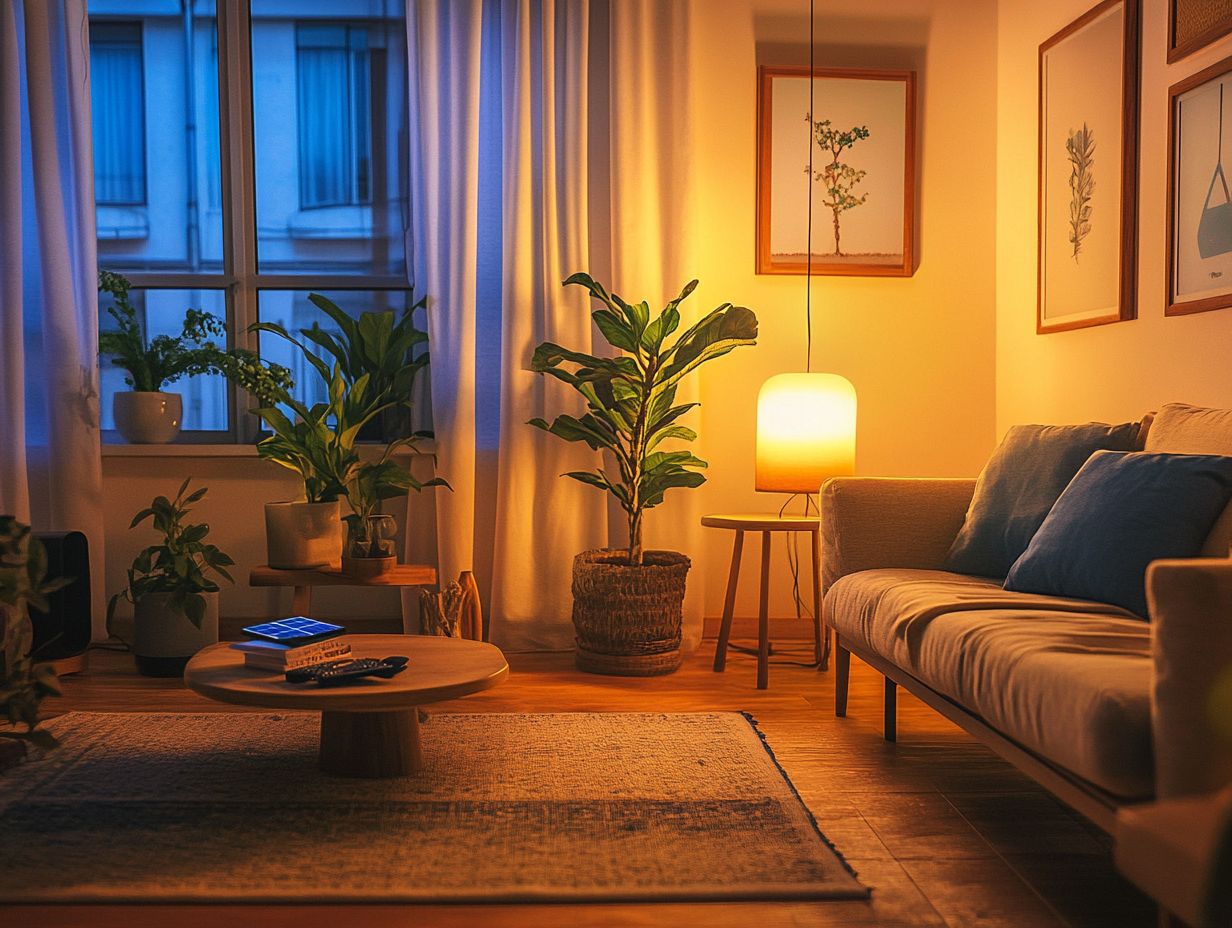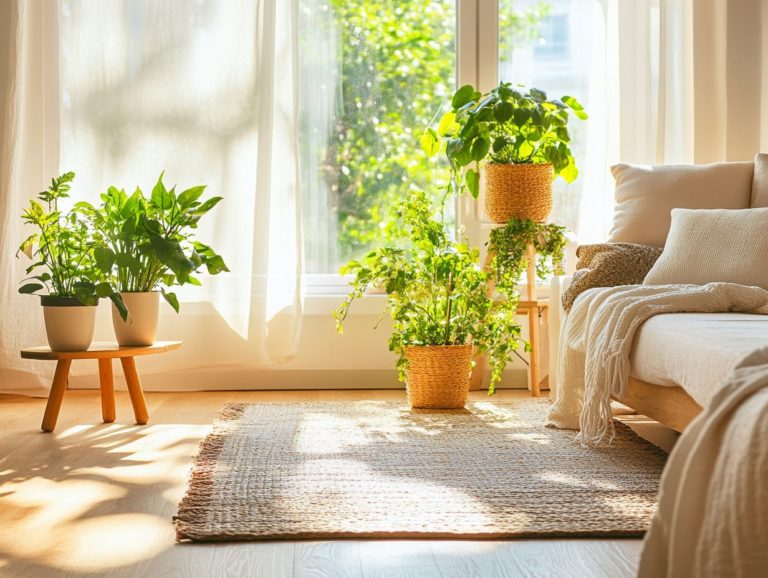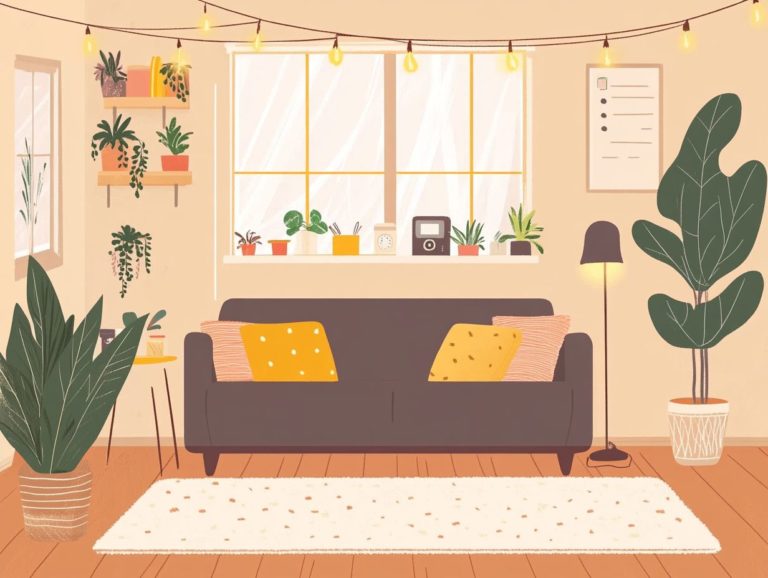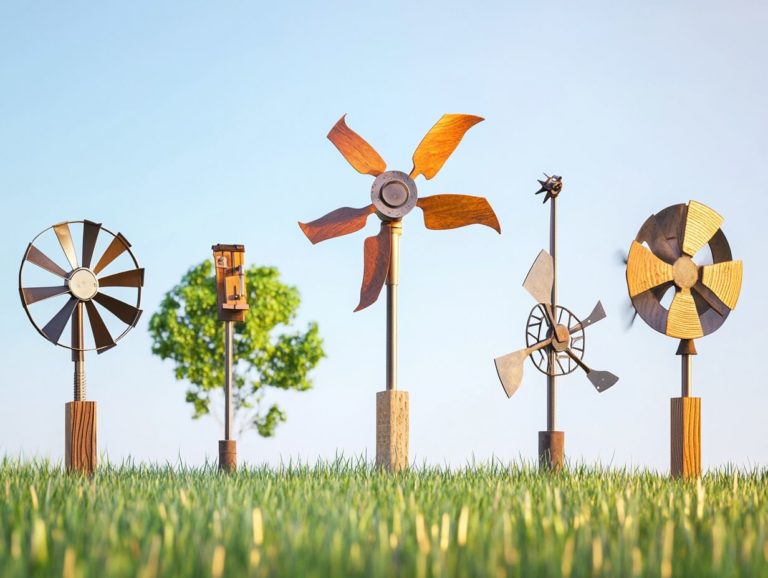5 Creative DIY Projects to Enhance Home Energy Efficiency
In a world that is increasingly prioritizing sustainability, enhancing your home s energy efficiency greatly helps the environment and saves you money on utility bills and heating costs.
Get ready to discover five exciting DIY projects that will supercharge your home’s energy efficiency! These projects cover everything from insulating your attic to constructing a rainwater harvesting system.
Whether you re a seasoned DIY enthusiast or just starting out, these projects are practical and within your reach.
Let s dive in! You can make a real impact on your living space and the planet with energy-efficient strategies!
Contents
- Key Takeaways:
- 1. Insulating Your Attic
- 2. Installing Weather Stripping on Doors and Windows
- 3. Creating a Solar Panel Out of Recycled Materials
- 4. Building a Rainwater Harvesting System
- 5. Making Your Own Energy-Efficient Light Bulbs
- Why Is Energy Efficiency Important for Homes?
- What Are the Benefits of DIY Energy Efficiency Projects?
- How Can These Projects Save Money in the Long Run?
- What Materials and Tools Are Needed for These Projects?
- What Are Some Other Creative DIY Projects for Home Energy Efficiency?
- How Can Homeowners Stay Motivated to Continue Improving Energy Efficiency?
- Frequently Asked Questions
Key Takeaways:

1. Insulating Your Attic
Insulating your attic is one of the most effective ways to improve your home’s energy efficiency. It significantly reduces heating bills and enhances overall comfort.
Installing the right insulation, like fiberglass or spray foam, minimizes air leaks. This keeps heat from escaping in winter and your home cool in summer.
By improving your insulation, you can save between 10% to 50% on heating and cooling costs. This makes it one of the best DIY projects for home energy savings.
Consider various insulation materials such as cellulose and mineral wool. They each offer unique benefits, and proper insulation of hot water pipes also helps with energy efficiency.
Before installing, ensure your attic is clean and any existing insulation is properly spaced. Regularly check for drafts and measure your insulation quality.
Use guidelines from energy.gov to find an R-value suitable for your climate. Following these tips will maximize energy efficiency and improve your home’s comfort over time.
2. Installing Weather Stripping on Doors and Windows
Installing weather stripping on your doors and windows is a straightforward yet impactful DIY project that significantly cuts down air leakage, enhancing your home s energy efficiency. By strategically sealing those sneaky spots where air tends to escape, you can keep drafts at bay, maintain a comfortable indoor temperature, and lower your heating and cooling costs. This is particularly useful for drafty windows and doors.
You’ll find a variety of weather stripping materials available on the market, each tailored for different needs and applications. Foam strips are often perfect for those drafty windows, while V-strips excel on the sides of doors. If you re looking for a budget-friendly option, felt can also be a great choice. To determine which material suits your specific doors or windows best, consider factors like the installation surface and how long you want it to last. Additionally, Low-E windows can further boost energy efficiency.
Installing these materials is typically a breeze and involves a few simple steps:
- Clean the area thoroughly.
- Measure the required length.
- Cut the strip to size.
- Adhere it in place, ensuring a snug fit.
With the right weather stripping in place, studies suggest that homes can achieve energy savings of 10-20%. This small project is not just simple it s a savvy investment in your home s comfort and efficiency.
3. Creating a Solar Panel Out of Recycled Materials
Creating a solar panel from recycled materials is not just a clever DIY project; it s a chance for you to embrace energy efficiency while championing sustainable practices that can help lower your home s energy costs. By repurposing everyday items and harnessing renewable energy, you can significantly minimize your carbon footprint, all while reaping the rewards of energy savings and distancing yourself from the ever-increasing utility bills. Solar panels are an excellent addition to any energy-efficient home.
You have a plethora of materials at your disposal for this project, including old glass, aluminum frames, and even bits and pieces from discarded electronics like solar cells salvaged from broken calculators. The magic of solar energy lies in its ability to convert sunlight into usable electricity through the process that turns sunlight into electricity. By undertaking this project, you can boost your home s energy efficiency, produce clean power, and reduce your dependence on fossil fuels.
As you dive into this endeavor, it’s crucial to prioritize safety; don’t forget your gloves and goggles during construction. Depending on the materials you choose, you might find your costs ranging from a budget-friendly DIY approach to a few hundred dollars. You can expect to enjoy significant savings on your electricity bills, as utilizing solar energy not only cuts costs but can also enhance your property’s value. For more insights, explore our guide on how to upgrade your home for energy efficiency.
4. Building a Rainwater Harvesting System

Building a rainwater harvesting system is an impressive DIY project that not only champions water conservation but also enhances energy efficiency in your home by lessening your dependence on municipal water supplies. This sustainable approach gives you the power to utilize natural resources, effectively lowering your water costs and shrinking the carbon footprint tied to water transport and treatment.
These systems are key players in reducing runoff and erosion, making them a proactive solution for managing stormwater. At the heart of your system are collection barrels that gather rainwater from your rooftop via gutters. To ensure the water is clean and safe for various uses, implementing effective filtration methods such as mesh screens or sediment filters is essential.
Once filtered, this precious resource can flow through a network of pipes and pumps, ready for irrigation or uses that don t require drinking water. By adhering to a straightforward setup and maintenance plan, you can enjoy the dual benefits of lower water bills and a meaningful contribution to sustainable living practices. This project can significantly reduce your dependence on municipal water supplies.
5. Making Your Own Energy-Efficient Light Bulbs
Creating your own energy-efficient light bulbs is an exhilarating DIY project that can truly transform your home lighting while greatly reducing energy use and costs. By choosing alternative lighting solutions, such as compact fluorescent lamps (CFLs) which offer a significant upgrade over traditional options or other energy-saving technologies, you can brighten your spaces without watching your electricity bills soar. Using programmable thermostats can also enhance your home’s energy efficiency.
If you re eager to explore the realm of green lighting, there are several intriguing modifications you can make to existing incandescent bulbs to boost their efficiency. Simple adjustments, like installing dimmer switches or using LED retrofits, can optimize your energy use without sacrificing brightness. Swapping out incandescent bulbs for CFLs can provide substantial energy savings.
CFLs provide a remarkable advantage over traditional incandescent options, offering around 70% more energy savings and a lifespan that can last up to ten times longer.
By making the switch, you won’t just reduce your electricity costs; you’ll also play a vital role in lowering your carbon footprint. This creates a more sustainable living environment with minimal effort on your part.
Why Is Energy Efficiency Important for Homes?
Energy efficiency is essential for your home, as it cuts down on energy consumption and lowers your heating bills. It also plays a crucial role in securing a sustainable future by reducing the carbon footprint linked to energy production and usage. Understanding the significance of energy efficiency equips you to make informed choices that benefit both the environment and your wallet, all while aligning with guidelines from reputable sources like energy.gov.
Residential energy consumption makes up nearly 20% of total energy use in the United States. Enhancing your efficiency can lead to remarkable benefits. For instance, investing in proper home insulation techniques can slash your heating and cooling costs by up to 20%. Energy-efficient appliances use up to 50% less energy compared to traditional ones. Programmable thermostats enable you to fine-tune your heating and cooling schedules, amplifying your energy savings even further.
Improving energy efficiency also cultivates healthier living conditions by minimizing indoor pollutants and maintaining stable temperatures. This creates a win-win scenario for both your household and the planet. Upgrade your appliances now for incredible savings and comfort!
What Are the Benefits of DIY Energy Efficiency Projects?
DIY energy efficiency projects offer numerous benefits, including reduced energy consumption, lower heating bills, and a smaller carbon footprint. Implementing projects such as sealing air leaks, installing energy-efficient appliances, and utilizing renewable energy sources like solar panels can enhance your home’s comfort and value while contributing to environmental sustainability. The Energy Department offers valuable resources and guidelines to help you maximize these benefits.
Engaging in DIY energy efficiency projects presents a wealth of advantages, including notable energy savings and reduced costs. You can also enjoy the gratifying feeling of enhancing your home environment while cutting down your carbon footprint. By tackling these projects, you not only improve your living spaces’ comfort but also play a vital role in fostering a more sustainable future through 5 ways to reduce energy waste at home with practical and innovative solutions.
Beyond the immediate financial relief reflected in your utility bills, these projects can boost your home’s overall value, making it attractive to potential buyers in today’s eco-conscious market. Simple initiatives like installing energy-efficient windows, adding insulation, or implementing programmable thermostats are among the most sought-after DIY endeavors that deliver impressive results. For more ideas, consider the top 10 energy-efficient home improvements. These enhancements not only decrease energy consumption but also instill a profound sense of achievement and pride in you as a homeowner.
If you’re considering embarking on DIY energy efficiency projects, start with energy audits to pinpoint areas needing improvement. This will ensure a focused and effective approach to crafting a more energy-efficient living space. For practical tips, check out 5 ways to improve your home’s efficiency today to unlock savings immediately!
How Can These Projects Save Money in the Long Run?

Implementing energy efficiency projects can save you money over time by reducing energy consumption and lowering your utility costs. When you invest in energy-efficient upgrades, those initial expenses are often quickly offset by lower heating and cooling bills, resulting in a strong return on your investment.
For example, upgrading to Low-E windows (which reflect heat back into your home) can reduce energy waste by an impressive 30-50%. This leads to lower heating costs in the winter and reduced cooling expenses in the summer. If your family replaces single-pane windows with Low-E options, you might save around $500 each year on energy bills, allowing you to recoup your investment in just a few years. Consider exploring 5 essential energy efficiency upgrades for homes to maximize your savings.
Installing programmable thermostats also allows you to automate your heating and cooling schedules, potentially saving you upwards of $180 each year. These savings add up, making such investments financially wise and essential for promoting a more sustainable way of living.
What Materials and Tools Are Needed for These Projects?
To tackle DIY energy efficiency projects successfully, you ll need a selection of materials and tools tailored to each task. This ensures that your efforts enhance both the energy efficiency and sustainability of your home. Familiarizing yourself with essential supplies for common projects will empower you to take on improvements with confidence.
For insulation upgrades, consider using fiberglass batts, foam boards, and spray foam sealant. These options play a crucial role in reducing heat transfer and can significantly lower your energy costs. For sealing gaps and drafts around windows and doors, weather stripping and caulking are must-have tools that offer quick yet effective solutions for energy leaks. Additionally, check out these 5 energy efficiency solutions for renters to enhance your home’s efficiency.
Switching to energy-efficient lighting, like LED bulbs, can dramatically cut your electricity consumption while providing better illumination. To find these materials at an affordable price, explore local hardware stores, online marketplaces, or community reuse centers. Choosing high-quality products will ensure durability, so look for well-reviewed brands and certifications that promise lasting performance.
What Are Some Other Creative DIY Projects for Home Energy Efficiency?
Exploring various creative DIY projects to enhance your home s energy efficiency can lead you to innovative solutions that save you money and promote sustainability and self-sufficiency. Whether you re building retractable screen doors or installing solar panels, you ll discover projects that align with your skills and contribute to a greener environment.
By diving into these initiatives, you can improve your living space while cultivating pride in your handiwork. Undertaking DIY projects like weather stripping windows, crafting homemade draft stoppers, or even constructing rain barrels for water conservation serves a dual purpose: enhancing energy efficiency and fostering a deeper connection with top energy-saving tips for homeowners.
The benefits are clear: reduced utility bills and a lower carbon footprint. Think about the challenges you might face, such as the necessary tools, time commitment, and varying skill levels for each project. However, the rewards significantly outweigh the obstacles, especially when considering 5 tips for energy-efficient home renovation, inspiring you to embark on these eco-friendly ventures and make a lasting positive impact.
How Can Homeowners Stay Motivated to Continue Improving Energy Efficiency?
Stay motivated to enhance your home’s energy efficiency by setting clear goals, tracking your progress, and celebrating your achievements. This approach fosters a sense of accomplishment and strengthens your commitment to sustainability.
Engaging in DIY projects can also spark ongoing efforts to improve energy efficiency in your home. It’s beneficial to outline specific, attainable energy efficiency objectives.
Breaking these goals into smaller, manageable projects with established timelines simplifies the process and allows for small wins, making the journey feel less overwhelming.
By creating or joining a community focused on sustainability, you can share insights, swap tips, and support one another, turning the endeavor into a shared experience. This sense of camaraderie enhances accountability and nurtures a positive environment where successes can be celebrated.
These celebrations will further motivate you to pursue your energy-saving aspirations.
Frequently Asked Questions

1. What are some easy DIY projects to enhance home energy efficiency?
Some easy DIY projects to enhance home energy efficiency include installing weatherstripping on doors and windows, using LED light bulbs, and insulating your attic and walls.
2. How can I make my home more energy efficient without breaking the bank?
There are many budget-friendly DIY projects to enhance home energy efficiency. Examples include installing a programmable thermostat, caulking gaps and cracks, and using a clothesline to air dry laundry.
3. Are there any DIY projects that can help reduce my water usage?
Yes, several DIY projects can help reduce water usage in your home. These include installing low-flow showerheads and faucets, fixing leaks promptly, and installing a rain barrel to collect and reuse rainwater.
4. Can I really save money on my energy bills by doing these DIY projects?
Absolutely! You’ll be amazed at how much you can save on your energy bills. These DIY projects may have an upfront cost, but they will save you money in the long run by reducing your energy consumption.
5. Do I need any special skills or tools to complete these DIY projects?
Most of these DIY projects can be completed with basic tools and skills. However, for more complex projects like insulating your walls, it may be helpful to research and seek professional guidance.
6. Are these DIY projects environmentally friendly?
Yes, these DIY projects are environmentally friendly as they help reduce energy and water usage in your home. They often involve using sustainable materials, such as LED light bulbs and natural insulation options.
Start implementing these tips today, and share your experiences with others!






